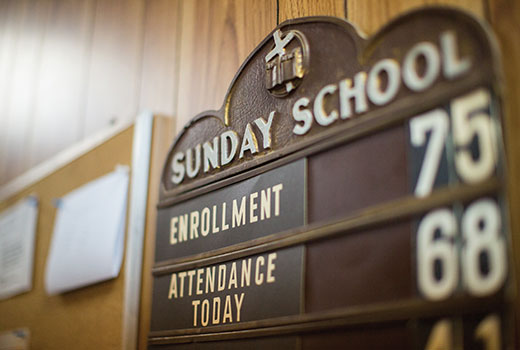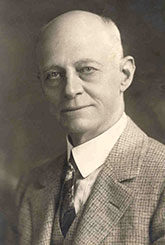From the mid-1940s to the mid-1950s, Southern Baptists lived on the cutting edge of church growth, primarily by growing strong and evangelistic Sunday schools.
Today we are viewed as a denomination in decline, with decreases in baptisms, worship attendance, church membership and Sunday school attendance spanning at least eight years.
If Sunday school was the tool that enabled us to lead the way in church growth, what has happened to Sunday school?
“It’s probably not a secret that Sunday school is no longer the en vogue program of the local church,” Ed Stetzer, former director of LifeWay Research, wrote in 2011. “You would be hard pressed to find a contemporary church plant that includes Sunday school as part of its structure.”
Stetzer went on to mention four things that have led to the demise of Sunday school or weakened its effectiveness: 1) A shift from transformed lives to church growth; 2) a move from volunteers to paid professionals; 3) a movement that became a program; and 4) a change from being children-focused to consumer-focused.
Sunday school in the beginning was just that: a one-day-a-week school for at-risk children on Sundays. In the wake of the Industrial Revolution, children became employees, often working 12 hours a day, six days a week. In 1780, in Gloucester, England, Robert Raikes saw the plight of these children and provided a way for them to get some education and avoid sinking into crime and despair. Sunday was the only day available for school for these youth. Children learned to read by reading the Bible. When Raikes died in 1811, there were approximately 400,000 children attending Sunday schools in Great Britain.
When compulsory education became the law, the emphasis of Sunday school shifted to Christian education exclusively. Sunday school became a productive way to evangelize and disciple people, and Southern Baptists led the way. In a sermon/research paper, “Baptists Are the New Methodists,” Chuck Kelley, president of New Orleans Baptist Theological Seminary, stated, “In 1945 the SBC [churches] baptized about 257,000 people. In 1955, about 417,000 people were baptized. Since 1955, the SBC never reached the mark of 450,000 baptisms. We doubled in 10 years, but then could not increase 35,000 in more than 50 years. What happened to the harvest?”
Kelley goes on to point out that we changed — not simply our methodology, but ourselves. In comparing the health of a farm to the SBC, he observed, “The spiritual state of the farmer (our churches and leadership), not the abundance of the harvest, is the root of problems in SBC evangelism. We are growing ever less distinct and recognizable in the crowd of our nation’s population. Our problem is not that more of us don’t witness to our neighbors. Our problem is that more of us do not look like and live like Jesus.”
 He noted that the characteristic of Southern Baptists at their best was a passionate evangelistic discipleship. “By that I mean an evangelistic discipleship that continually seeks to incorporate both evangelism and discipleship at the same time,” he stated. As a farmer needs to cultivate his crops, Kelley said Sunday school became the “cultivation strategy for SBC churches,” adding, “It was the only thing you could join in an SBC church without being a member.”
He noted that the characteristic of Southern Baptists at their best was a passionate evangelistic discipleship. “By that I mean an evangelistic discipleship that continually seeks to incorporate both evangelism and discipleship at the same time,” he stated. As a farmer needs to cultivate his crops, Kelley said Sunday school became the “cultivation strategy for SBC churches,” adding, “It was the only thing you could join in an SBC church without being a member.”
Steve Rohrlack, whose assignment with the South Carolina Baptist Convention is church strengthening and discipleship, believes the “key to revitalization is when we combine evangelism and discipleship.” He also pointed out that the strongest Sunday schools in our state are those where Sunday school is constantly promoted from the pulpit.
Stetzer said that if the Sunday school hour can be retooled, it will need to move from “consumerist education to gospel-centered disciple making, teaching the full counsel of God to those seeking to live it. The impact could be great.”
Steve Lemeke, provost at New Orleans Seminary, pointed out that evangelism was driven by Sunday school, but many churches today have accepted the theory that worship should drive evangelism. He said many churches “have de-emphasized Sunday school, and stopped working the principles of Flake’s formula through Sunday school.”
Arthur Flake was a businessman who became the head of the Southern Baptist Convention’s Sunday School Board (“Department of Administration”) in 1920. He formulated a five-point formula for Sunday school success in his 1919 book, “Building a Standard Sunday School”: 1) Know the possibilities (locate the prospects); 2) enlarge the organization (start new classes); 3) recruit and train workers (leaders); 4) provide the place; and 5) go after the people.
In 1922, Flake stated that Sunday school “is the church’s greatest soul-winning opportunity.” By 1957, Life Magazine was calling Sunday school “the most wasted hour of the week.” A USA Today article published on March 22, 2015, carried the headline: “Has the Sun Set on Sunday School?”
After at least eight years of decline in the SBC in baptisms, worship attendance, church membership, and Sunday school attendance, the fact of decline is clear. Kevin Ezell, president of the North American Mission Board, said, “Viewed through the lens of any research you look at, Southern Baptist churches are in the midst of a health crisis and have been for many years.”
Stetzer has said, “Facts are our friends, and the fact is the SBC decline is not reversing. It is accelerating.”
Could a revitalized Sunday school/small group ministry committed to evangelism and discipleship be the answer to our demise? According to many of our leaders, Flake’s formula works as well in business as it does in church and can be as effective in small groups today — both on campus and off — as it was during the Sunday school growth era.
Sunday school is still around. It is ailing (we declined from 4,205,977 in 2011 to 3,605,303 in 2015), but its viability for the future is not directly related to methodology but to the commitment of God’s people to live like Jesus and obey His Great Commission.



